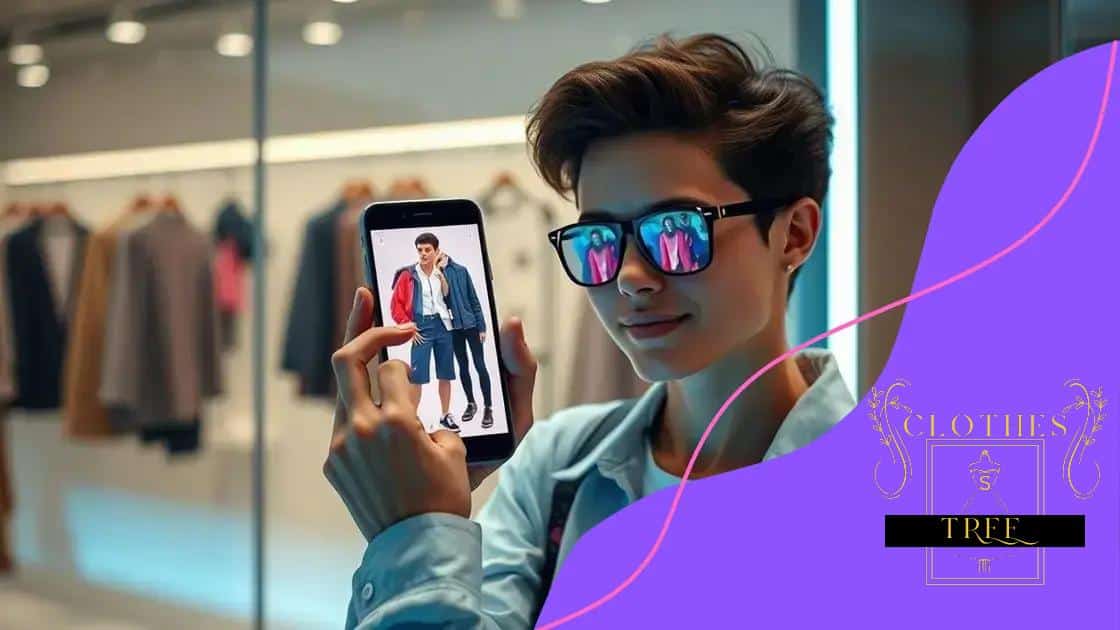How Shein’s virtual try-on features educate consumers

How Shein’s virtual try-on features educate consumers by providing interactive experiences that enhance confidence, reduce returns, and promote informed purchasing decisions through advanced augmented reality technology.
How Shein’s virtual try-on features educate consumers is a fascinating topic in today’s shopping landscape. As more people turn to online shopping, these innovative tools help customers make informed choices and reduce return rates. Don’t you wonder how these technologies reshape our buying habits?
Understanding Shein’s virtual try-on technology
Understanding Shein’s virtual try-on technology is crucial for consumers looking to enhance their online shopping experience. This innovative tool allows users to visualize how clothes will fit them without physically trying them on, transforming the way we shop online.
Shein utilizes advanced algorithms and augmented reality (AR) to create a seamless fitting experience. By simply uploading a photo or using a 3D model, shoppers can see how garments look on their body type. This capability reduces uncertainty and boosts confidence in making purchase decisions.
The technology behind virtual try-on
This technology relies heavily on machine learning and computer vision. It analyzes the user’s body shape and measurements to create a personalized fitting experience. As users interact with the app, the system learns and improves, providing better fit predictions over time.
Benefits of using virtual try-on features
- Convenience: Try on outfits from the comfort of home.
- Reduces returns: Helps minimize the likelihood of ordering the wrong size.
- Interactive shopping: Engages users in a fun and memorable way.
Through these features, consumers not only gain a better understanding of how clothes will suit them but also enjoy an engaging shopping experience. Virtual try-on technology also encourages users to explore fashion in new ways, breaking traditional shopping barriers.
The more consumers interact with this technology, the more they appreciate its value. By providing a more tailored shopping experience, Shein empowers customers to make informed decisions. This innovative approach is paving the way for the future of online fashion.
The benefits of virtual try-on for consumers
The benefits of virtual try-on for consumers are transforming the online shopping landscape. With the rise of technology, shoppers now have access to tools that enhance their experience and make clothing purchases more enjoyable.
One of the biggest advantages is the ability to visualize how apparel will fit. This technology reduces uncertainty, allowing users to make more informed choices when selecting sizes and styles. Customers can see how different colors and designs will appear on them without the hassle of physical try-ons.
Key advantages of virtual try-on
Consumers can enjoy several key benefits from virtual try-on features:
- Increased confidence: Shoppers gain the assurance they need before making a purchase.
- Time-saving: No more waiting in lines at fitting rooms or dealing with crowded stores.
- Broader selections: Easily explore various styles without the limitations of in-store inventory.
This technology also plays a role in reducing returns. When customers can virtually try on clothes, they are less likely to order the wrong size or style. This can significantly decrease return rates, which benefits both consumers and retailers. Less waste in returns also contributes positively to the environment.
Additionally, virtual fitting rooms create a more engaging shopping experience. By interacting with the technology, customers find shopping to be more enjoyable and less of a chore. They feel empowered to explore new styles and trends, leading to a more satisfying overall experience.
Ultimately, these benefits revolutionize how consumers approach online shopping. With the integration of virtual try-on technology, Shein provides a platform that prioritizes convenience, confidence, and exploration in fashion.
How virtual fitting rooms influence buying decisions

How virtual fitting rooms influence buying decisions is an important aspect of modern online shopping. These digital spaces are changing how consumers perceive and interact with products, leading to more confident purchasing choices.
Virtual fitting rooms allow shoppers to see how clothes fit them in a realistic way, which affects their decisions significantly. When users can visualize clothing on themselves, they feel more comfortable about what they are buying. This technology can simulate how fabrics drape and fit, making the shopping experience more interactive.
The impact on customer confidence
With the ability to virtually try on different outfits, customers experience increased confidence in their selections. They can check their looks in various styles, which helps them commit to purchases they might otherwise hesitate to make. This boosted confidence often leads to fewer returns, benefiting both the shopper and the retailer.
Engagement and exploration
Another way these virtual fitting rooms influence decisions is by enhancing engagement. Shoppers often spend more time exploring different items when they can see how they would look in real life. This exploration not only keeps consumers entertained but also encourages them to discover new fashion choices they might not have considered otherwise.
- Personalization: Virtual fitting rooms can recommend options based on previous selections.
- X-factor: Users are more likely to share their virtual looks on social media, boosting brand visibility.
- Emotional connection: Seeing themselves in new outfits fosters a connection to the style.
As shoppers interact with these rooms, they often find themselves making purchases they truly love. The ability to visualize clothing in a familiar context, like their own body, is a powerful tool for driving sales and improving satisfaction.
The result is an enriched shopping experience that prioritizes customer needs and desires. As virtual fitting room technology evolves, it continues to shape not only how we shop but also what we choose to buy based on our unique preferences and styles.
Consumer education through augmented reality
Consumer education through augmented reality is revolutionizing the way shoppers make informed decisions. With technology rapidly advancing, AR tools provide an interactive experience that enhances understanding and engagement.
Augmented reality allows consumers to visualize products in their real-world context. For instance, when trying on clothes virtually, consumers can see how different styles fit into their wardrobes. This not only helps them make better choices but also encourages experimentation with new looks.
Benefits of AR in consumer education
One major benefit of using augmented reality is that it fosters a deeper understanding of products. Through AR, consumers can:
- Access detailed information: AR can provide insights about fabrics, care instructions, and styling tips.
- Experience products virtually: Users can see how items look on them or in their home environment before buying.
- Make comparisons: Shoppers can compare different options easily, enhancing their decision-making process.
As consumers engage with these AR features, they become wiser shoppers. This empowerment leads to greater satisfaction with their purchases. It also reduces the likelihood of buyer’s remorse, as customers have a clearer understanding of what they are buying.
Moreover, AR technology can be used to educate consumers about sustainability. Virtual platforms can highlight eco-friendly brands and practices, helping shoppers choose options that align with their values. By understanding the impact of their purchasing decisions, consumers can make choices that are better for themselves and the planet.
Incorporating augmented reality into shopping creates an educational experience that benefits both the consumer and the retailer. As shoppers become more knowledgeable, they develop a stronger connection with brands, leading to loyalty and repeat business.
Future trends in fashion virtual experiences
Future trends in fashion virtual experiences are set to transform the retail landscape even further. As technology advances, we can expect a range of innovative features that enhance how consumers interact with fashion.
One of the key trends is the integration of artificial intelligence (AI) with virtual reality (VR) and augmented reality (AR). By combining these technologies, brands will create immersive shopping experiences tailored to individual preferences. Imagine walking through a virtual store where clothes are modeled on avatars that resemble your own body type.
Personalization and customization
Future virtual experiences will prioritize personalization, allowing consumers to customize their shopping experiences. Shoppers may soon interact with AI that learns their style preferences, making recommendations based on their previous purchases and browsing behavior. This will lead to a more engaging and effective shopping journey.
Enhanced social shopping
Another trend will be enhanced social shopping experiences. Virtual fitting rooms could allow groups of friends to shop together online. They can share opinions in real-time about what looks best on each other. This social interaction can make the online shopping experience much more enjoyable.
- Virtual events: Brands may host online fashion shows where consumers can shop items directly from the runway.
- AR fitting rooms: As AR technology improves, it will provide more realistic and interactive fitting experiences.
- Gamification: Incorporating game-like elements can make shopping more fun and engaging, keeping consumers returning for more.
Furthermore, sustainability will play a crucial role in future virtual fashion experiences. Brands will leverage virtual tools to promote sustainable practices, educating consumers about eco-friendly choices while shopping. By showcasing how garments are made and the materials used, brands can encourage more conscious consumerism.
Overall, as virtual experiences evolve, they will continue to make shopping more personalized, interactive, and sustainable. The future of fashion will not only be about what we wear but also how we experience it, creating a deeper connection between consumers and brands.
FAQ – Frequently Asked Questions about Virtual Try-On Technologies
How do virtual fitting rooms enhance my shopping experience?
Virtual fitting rooms allow you to try on clothes digitally, helping you visualize how they fit and look before making a purchase.
What technology is behind virtual try-on features?
These features use augmented reality (AR) and artificial intelligence (AI) to create realistic models of how clothes will appear on your body.
Can virtual try-on technology reduce returns?
Yes, by allowing you to see how items look on you, it decreases the likelihood of buying the wrong size or style, thus reducing returns.
What role does consumer education play in virtual shopping?
Virtual platforms educate consumers about products, including fit, materials, and styling tips, making them more informed and confident buyers.





